IDEX Online Research: Jewelry Price Inflation Flares At Retail and Producer Level in November
December 23, 09
Inflation is back. Both retail and producer prices of jewelry jumped in November.
What is behind this surge in jewelry prices? Most people say that jewelry price inflation is being driven by higher gold prices. Unfortunately, the numbers tell a different story: prices for precious metal jewelry at the producer level were up less than for other categories such as gemstone jewelry. But, make no mistake: all categories of jewelry posted higher prices in November.
Here’s a summary of the two key jewelry industry inflation indices – the Jewelry Consumer Price Index (JCPI) and the Jewelry Producer Price Index (JPPI) – for November 2009 versus the same month a year ago:
· November 2009 Jewelry Consumer Price Index – +2.4 percent
· November 2009 Jewelry Producer Price Index – +9.7 percent
Conventional economics tells us that these inflationary trends can’t continue. Demand at retail remains muted. Thus, weak demand will not allow retailers and producers to continue to push through higher prices.
Further, for most of 2009, inflation at the jewelry producer level has been greater than at the retail level. For the full year, jewelry prices at the consumer level are expected to rise by 2 percent or so. At the producer level, jewelry prices are predicted to rise by about 3 percent. With producer prices rising faster than retail prices, jewelry store owners have two choices: 1) raise prices; or 2) absorb the cost increases and experience shrinking margins. The choice is obvious: higher retail prices are on the way. Every link of the distribution pipeline has experienced margin pressure over the past few years, and there is no more room for margin shrinkage.
The graph below compares the Jewelry Consumer Price Index to the Jewelry Producer Price Index by month for 2009.
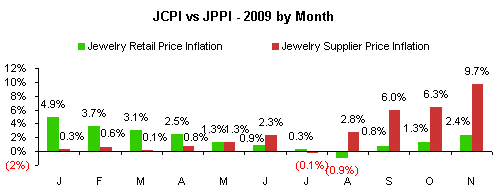 Source: BLS |
November 2009 Jewelry Producer Price Inflation +9.7 percent
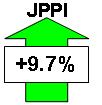 |
The November JPPI inflation rate of +9.7 percent was far higher than the average of the Jewelry Producer Price Index for 2008, which averaged +6.3 percent for the full year. Further, the +9.7 percent inflation rate in November is substantially above the annual inflation rate – which averaged about +0.7 percent – that characterized the jewelry producer industry in 2000 through 2002, also a recessionary period. November’s inflation rate was also above the long term Jewelry Producer Price Index increase of about +1.4-1.5 percent annually.
The following graph summarizes the monthly Jewelry Producer Price Index for inflation for 2008 and 2009. The percentage figures are based on year-to-year comparisons of the BLS Jewelry Producer Price Index (November 2009 versus November 2008).
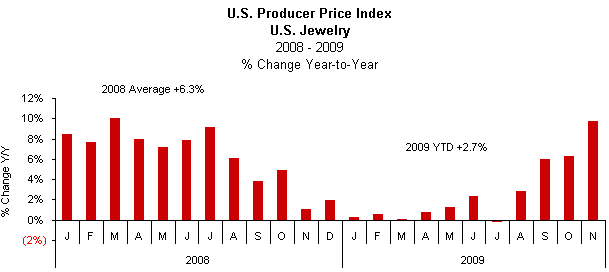 |
Inflation By Commodity Up Sharply in November vs. Earlier Months
After showing only very modest increases earlier this year, prices for both precious metal jewelry and gemstone jewelry rose in the second quarter, fell back in July, bounced upward in August, rose sharply in the third quarter, and spiked in November. The graph below compares the JPPI (red bars) to inflation for precious metals (gold bars); gold had been the primary driver of precious metals inflation in 2007 and most of 2008. In January 2009, gold prices pulled back modestly, but recently risen sharply. In our opinion, $1,100 or higher gold has been priced into goods produced by jewelry manufacturers. If gold remains high, as some analysts suggest, that will put further pressure on jewelry suppliers to raise prices.
As the graph below illustrates, prices for precious metals used in jewelry at the supplier (producer) level showed notable inflation, retreated in July, and returned in the third quarter, and spiked in November.
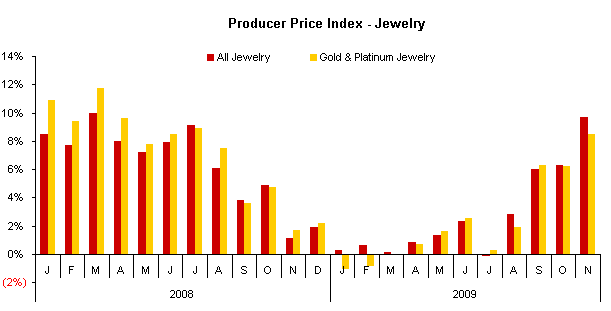 Source: BLS |
Watch Prices Bouncing
Like all producer prices, watch prices heated up in 2008, and remained high through the early spring of 2009. In the late summer, watch price inflation nearly evaporated, but began bouncing around in the third quarter. This price index reflects revisions which were made to the Watch Producer Price Index in August.
The following graph summarizes producer price inflation and deflation for watches in the
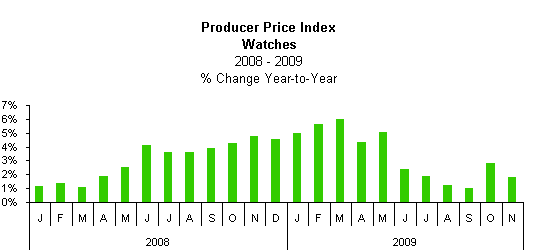 Source: BLS |
Jewelry Consumer Price Index (JCPI) +2.4 percent in November
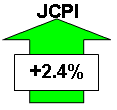 |
For the full year 2008, retail price inflation for jewelry in the
The graph below summarizes the percentage change in retail prices of jewelry and watches by month on a year-to-year basis since the beginning of 2008. The percentage change is based on a comparison to the same month a year ago (November 2009 versus November 2008).
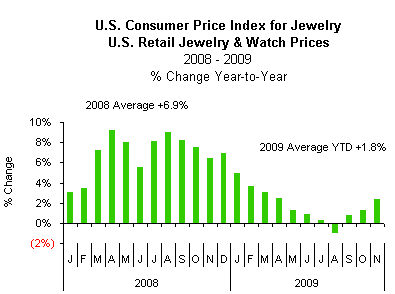 Source: BLS |
Watch Prices Dropping
After bouncing around for several months, it became clear in the second quarter of 2009 that watch price inflation at the retail level was moderating. Early in 2008, the components of jewelry and watch price inflation at the retail level reflected a disparity in price increases. Jewelry retail prices were up consistently during the first half of 2008, but watch retail prices showed virtually no price inflation.
Earlier this year, watch price inflation steadily increased at the retail level. In April, watch price inflation slowed dramatically. In May, retail prices of watches inched higher than in April, but the inflation rate was still below earlier months in 2009. In June, watch price inflation diminished significantly. In July, August, and September, watch prices dipped – experienced deflation – in the
The graph below illustrates the JCPI consisting of both jewelry and watch prices (green bars), jewelry prices only (red bars), and watch prices (yellow bars). For the month of November, retail prices of watches declined by 4.1 percent, according to the BLS, by far the sharpest decline this year.
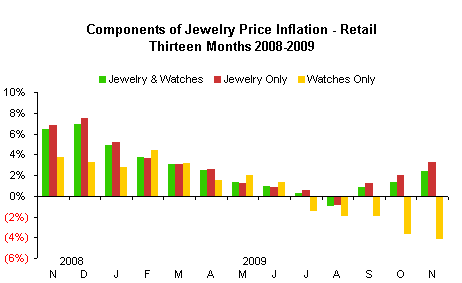 Source: BLS |
Something’s Got To Give: Retail Demand Won’t Support Higher Jewelry Prices
In an efficient economy, supply and demand factors are responsible for price movement of goods. However, in the jewelry industry, there is a disconnect in the current environment. Producer prices are rising sharply because component costs are up significantly – pushed higher by demand in other industries beyond jewelry. Retail prices are rising, since merchants cannot continue to absorb higher cost goods without passing those cost increases on to consumers.
However, consumer demand remains lackluster. While there has been some pickup in shoppers’ demand for jewelry in the past two months, it is not enough to justify – or support – higher jewelry prices, either at retail or at the supplier level.
The graph below compares jewelry sales trends (October is the latest data) with the Jewelry Consumer Price Index (November is the latest data).
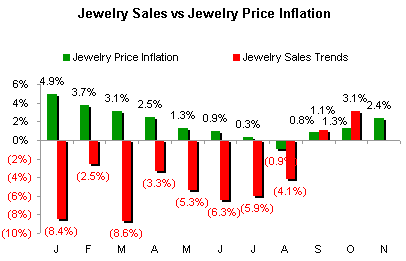
Source: Dept. of Commerce & BLS
Outlook: Modest Jewelry Price Inflation in 2009
After rising by nearly 7 percent in 2008, we continue to forecast much more modest jewelry and watch price inflation during 2009. The wild cards, of course, relate to commodity prices, including gold, silver, and platinum. If investors continue to buy these precious metals as hedges against inflation – as historical economic recovery models suggest – it will put upward cost pressure on jewelry suppliers, who will try to pass those price increases along to retailers.
Further, a new wild card has been added to the mix: the value of the U.S. dollar. It has always been lurking in the wings, but it appears to be an active player in today’s market as a determinant of inflation.
Inflation returned to the jewelry industry in the third quarter, and it is building.
Our current prediction calls for 2009 jewelry price inflation to be in the low single digit positive level – likely just below 2 percent, as the graph below illustrates. The
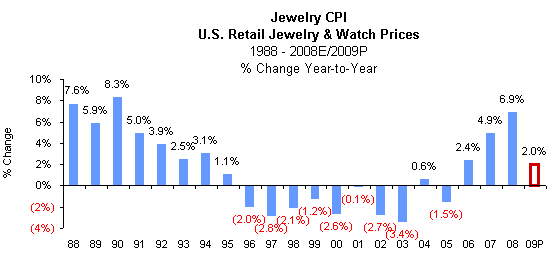
Source: BLS & IDEX Online